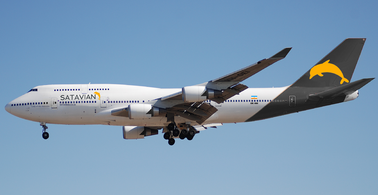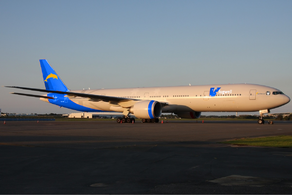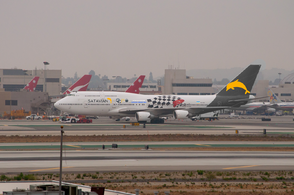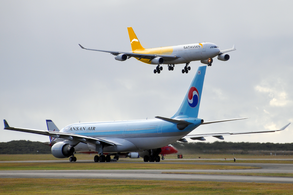User:Norcandy/Sandbox/Satavian: Difference between revisions
No edit summary |
mNo edit summary |
||
| Line 9: | Line 9: | ||
| callsign = SATAVIAN | | callsign = SATAVIAN | ||
| founded = {{Start date and age|df=yes|1935|01|23}} (as [[Satavian Imperial Airways Corporation]]) | | founded = {{Start date and age|df=yes|1935|01|23}} (as [[Satavian Imperial Airways Corporation]]) | ||
| commenced = {{Start date and age|df=yes| | | commenced = {{Start date and age|df=yes|2007|12|18}} (as Satavian Airlines) | ||
| ceased = | | ceased = | ||
| aoc = | | aoc = | ||
| Line 63: | Line 63: | ||
For the early part of the 1980s, Satavian Airways prospered as it was the only major airline in Satavia, capturing both the business and leisure market. Its rapid expansion across [[Euclea]] was remarkable, and soon it operated one of the world's largest fleets. | For the early part of the 1980s, Satavian Airways prospered as it was the only major airline in Satavia, capturing both the business and leisure market. Its rapid expansion across [[Euclea]] was remarkable, and soon it operated one of the world's largest fleets. | ||
===1988- | ===1988-2007: Air Satavia and downfall=== | ||
[[File:Air Satavia (2004; A319).png|thumb|left|230px|Air Satavia {{wpl|Airbus A319}} ''SX-KBO'']] | [[File:Air Satavia (2004; A319).png|thumb|left|230px|Air Satavia {{wpl|Airbus A319}} ''SX-KBO'']] | ||
In late 1988, with the election of a [[Conservative & Country Party (Satavia)|Conservative & Country]] government, a huge privatisation programme began in Satavia, that saw a vast majority of state-owned enterprises sold to investors - and in December 1988, Satavian Airways was listed on the [[Port Hope Stock Exchange]] for the first time: a consortium lead by Arthur Moyne (son of Neville Moyne, founder of Satavian Airways' predecessor) and the Estmerish-Jindanese conglomerate the {{wpl|Swire Group|Dane Group}}. The airline was re-branded as 'Air Satavia' and continued it's rapid expansion plans. | In late 1988, with the election of a [[Conservative & Country Party (Satavia)|Conservative & Country]] government, a huge privatisation programme began in Satavia, that saw a vast majority of state-owned enterprises sold to investors - and in December 1988, Satavian Airways was listed on the [[Port Hope Stock Exchange]] for the first time: a consortium lead by Arthur Moyne (son of Neville Moyne, founder of Satavian Airways' predecessor) and the Estmerish-Jindanese conglomerate the {{wpl|Swire Group|Dane Group}}. The airline was re-branded as 'Air Satavia' and continued it's rapid expansion plans. | ||
| Line 71: | Line 71: | ||
In 1993, Air Satavia launched a dedicated regional airline that serviced smaller airports in Satavia and Nuvania, [[SatavianExpress|SatavianDolphin]], as Air Satavia ,made its first attempt to break into neighbouring Nuvania's aviation market, which at the time was experiencing a huge increase in demand. However, by 1999 SatavianDolphin had ended its Nuvanian operations as it struggled to compete with established Nuvanian carriers, such as NLM and it's regional subsidiary [[NLM Express]]. | In 1993, Air Satavia launched a dedicated regional airline that serviced smaller airports in Satavia and Nuvania, [[SatavianExpress|SatavianDolphin]], as Air Satavia ,made its first attempt to break into neighbouring Nuvania's aviation market, which at the time was experiencing a huge increase in demand. However, by 1999 SatavianDolphin had ended its Nuvanian operations as it struggled to compete with established Nuvanian carriers, such as NLM and it's regional subsidiary [[NLM Express]]. | ||
As Air Satavia became larger and more ambitious, it began expanding into the wider Transportation and Hospitality market, in 2001 opening the first of a chain of limited service budget hotels, [[Hotelair]], in [[Cuanstad]]. Later that year it began ferry operations across the [[Van Horn Straight]] with [[AirFerries]], and in 2003 began it's own inter-provincial coach service, [[Satavian Airlines|AirCoach]]. Ultimately, none of these ventures would be profitable and contributed to Air Satavia's | As Air Satavia became larger and more ambitious, it began expanding into the wider Transportation and Hospitality market, in 2001 opening the first of a chain of limited service budget hotels, [[Hotelair]], in [[Cuanstad]]. Later that year it began ferry operations across the [[Van Horn Straight]] with [[AirFerries]], and in 2003 began it's own inter-provincial coach service, [[Satavian Airlines|AirCoach]]. Ultimately, none of these ventures would be profitable and contributed to Air Satavia's nationalisation in 2006. | ||
The [[Financial Crash of 2005]] saw Air Satavia slide into debt as demand for leisure routes decreased, and soon Air Satavia's operating costs far outweighed its revenue. Hotelair alone declared a loss of G490 million at the end of that year. In early 2006, in an attempt to keep the struggling airline afloat, longstanding CEO [[Richard Westham]] was replaced by [[Petter Desnoo]], who promised to cut back on expenditure and unnecessary luxuries. Despite the grounding of nearly 70% of the airlines' fleet, it still was wracking up enormous debts and by September of that year it became clear to industry experts that without drastic measures the airline would collapsed. | The [[Financial Crash of 2005]] saw Air Satavia slide into debt as demand for leisure routes decreased, and soon Air Satavia's operating costs far outweighed its revenue. Hotelair alone declared a loss of G490 million at the end of that year. In early 2006, in an attempt to keep the struggling airline afloat, longstanding CEO [[Richard Westham]] was replaced by [[Petter Desnoo]], who promised to cut back on expenditure and unnecessary luxuries. Despite the grounding of nearly 70% of the airlines' fleet, it still was wracking up enormous debts and by September of that year it became clear to industry experts that without drastic measures the airline would collapsed. | ||
The Satavian Government, lead by [[Prime Minister of Satavia|Prime Minister Edward Norton]] first considered a rescue plan in early 2006, but following the Airline's appointment of Petter Desnoo and claims that it was recovering from the initial shock of the financial crash it ceased plans for a rescue package. However, as the airline continued to lose money | The Satavian Government, lead by [[Prime Minister of Satavia|Prime Minister Edward Norton]] first considered a rescue plan in early 2006, but following the Airline's appointment of Petter Desnoo and claims that it was recovering from the initial shock of the financial crash it ceased plans for a rescue package. However, as the airline continued to lose money the government proposed it's rescue plan, which was soon approved unanimously by the Air Satavia board of directors. | ||
=== | In December 2006, the airline was re-nationalised and entered a period of reconstruction and reorganisation. Air Satavia CEO Petter Desnoo was replaced by [[Jack Lawson]], who had previously served as CEO of Estmair for 3 years, from 2002-2005, in addition to a large part of the airline's management. Air Satavia's ventures into other forms of transportation and hospitality and transportation were sold-off and a large portion of the carrier's fleet was also sold. As part of the nationalisation programme, the government had injected a little over G1 billion, most of which was used to clear the airlines debts. Following the sell off of much of the carrier's ageing fleet and cut-back on unnescesary expenditure, the airline would return in a new-look form in December of 2007. | ||
===2007-present: Satavian Airlines=== | |||
==Corporate affairs== | ==Corporate affairs== | ||
Revision as of 15:42, 13 April 2022
 | |||||||
| |||||||
| Founded | 23 January 1935 (as Satavian Imperial Airways Corporation) | ||||||
|---|---|---|---|---|---|---|---|
| Commenced operations | 18 December 2007 (as Satavian Airlines) | ||||||
| Hubs | Port Hope/O'Connell | ||||||
| Secondary hubs | Port Arthur/Fort Kinnon Victoriaburg | ||||||
| Frequent-flyer program | SkyPoints | ||||||
| Alliance | Sky Alliance | ||||||
| Subsidiaries | SatavianExpress Vlugwel | ||||||
| Fleet size | 98 | ||||||
| Destinations | 65 | ||||||
| Parent company | Government of Satavia (66%) | ||||||
| Traded as | PHSX: SATX | ||||||
| Headquarters | Greystone, Port Hope, Hope Province, Satavia | ||||||
| Key people | Derek Moyne, Chairman Jack Lawson, CEO | ||||||
| Revenue | |||||||
| Operating income | |||||||
| Net income | |||||||
| Employees | 18,339 | ||||||
| Website | satavian | ||||||
Satavian Airlines Corporation Ltd, commonly known as Satavian Airlines, is the flag carrier of Satavia and its largest airline by fleet size, international destinations and passengers carried. Satavian Airlines is one of the world's oldest airlines through its predecessor companies, with Satavian Imperial Airways Corporation, commonly known as SIAC, the oldest of those, founded in 1935 to provide a trans-Vehmens service from Port Hope, at the time capital of the Dominion of Satavia to Morwall, Estmere. Satavian Airlines dominated the Satavian commercial aviation industry during the late 20th century and into the early 21st century but struggled to survive following the 2005 global financial recession. In 2006, the airline fell into enormous debt, before being rescued by the Norton government, which began a huge reconstruction process that saw the airline lose a large portion of its market share both internationally and domestically.
Satavian Airlines remains one of the largest airlines in the Asterias, and is a founding member of Sky Alliance, the world's second-largest airline alliance, through its predecessor Air Satavia. Satavian Airlines operates a fleet of 98 aircraft, across 65 destinations on all four inhabited continents. The airline operates primarily out of its main hub in Port Hope O'Connell International Airport, the larger of the two airports that service Port Hope, in addition to smaller operations originating from Port Arthur-Fort Kinnon International Airport and Victoriaburg Fort Zilverzee International Airport. Its headquarters are in the Greystone suburb of Port Hope, adjacent to Port Hope/O'Connell Airport, situated in Burnaby.
The airline operates a fleet consisting of Airbus A220, Airbus A320, Airbus A321, Airbus A330, Airbus A350, Boeing 747 and Boeing 787 aircraft. Following the nationalisation of the airline in 2006, the airline moderninsed it's ageing fleet. The airline has won Airtrax Best Asterian Airline for three consecutive years, in 2017, 2018 and 2019.
History
1935-1939: The early years
Following Satavia's liberation towards the end of the Great War, Neville Moyne, a wealthy Estmerish businessman, sought to connect Satavia, at the time a part of the Estmerish Empire, to Morwall. On 23 January 1935, Satavian Imperial Airways Corporation, operating a Armstrong Whitworth Atalanta aircraft, flew the first trans-Vehmens flight of the Airline, carrying eleven passengers (including Moyne) and mail. The aircraft, registered G-SVAA Dominion, flew Port Hope-Fort Kinnon-Kingsport-Port Fitzhubert-Montecara-Bouley before arriving in Morwall on 14 February, to find that the war had ended.
Within the same year, the airline (now partly-owned by the Estmerish Overseas Airways Corporation) had expanded its operations to become the largest airline in Satavia. When Satavia declared independence in 1936, the airline's focus was diverted from operating the Port Hope-Morwall connection (although it maintained this route, with less frequent flights) to the Asterian market. In 1937, SIAC began operating flights to Asteria Inferior for the first time, with a twice-weekly rotation from Port Hope Aerodrome to Liberty City Airfield. Later that year, Neville Moyne took the opportunity to raise capital for four brand new Spartan Cruiser aircraft, decreasing his own stake in the company to 33%. By 1939, the airline had grown to become one of the largest in Asteria Inferior, and had acquired many of its rivals in the region. In February 1939, a military coup displaced the elected government and brought an end to the Union of Satavia.
1939-1988: Satavian Airways and merger with SRA
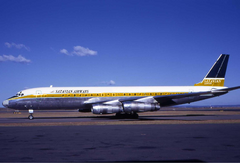
By late 1939, tensions between Satavia and some of its Asterian neighbours hostile to the coup forced the airline to cancel many of its international routes - including the Port Hope-Morwall connection that the airline had been founded upon. The effects of this, coupled with a financial crisis that gripped the nation in the aftermath of the coup forced the airline into debt. In response, the Satavian military government nationalised the airline, rebranding it as Satavian Airways. For much of the 1940s, the airline struggled to turn a profit whilst running primarily domestic routes and started losing out to privately-owned competitors, such as Satavian Regional Airlines. SRA became Satavian Airways's largest competitor and began a price war which saw aviation in Satavia increasingly become more accessible and cheaper to the wider public before it did in many other nations.
The price war continued into the early 1950s but was ultimately unsustainable for both airlines, and so resulted in the Aviation (Pricing & Regulations) Act, 1955 which saw both airlines forced to abandon many competing routes in an attempt by the government to control the airlines. Whilst Satavian Airlines had lost significant ground domestically, it had an effective monopoly on international routes originating in Satavia, and was able to rapidly expand into friendly Asterian states.
In the 1960s, Satavian Airways would be revitalised and began to target the leisure market that had previously been the domain of other Asterian carriers, such as Nuvanian flag-carrier NLM and the Imaguan Civilian Air Service, which both offered more competitive prices. Satavian Airways offered Asteria's first package holiday in 1961, with a flight from Port Hope/O'Connell to Peter Hansson International Airport in Imagua.
By the late 1960s, Satavian Airways' main competitor, SRA, had fallen into debt as it struggled to keep up with Satavian Airways and its significantly larger budget. In 1969, SRA went into a state of insolvency, and facing the collapse of Satavia's second-largest airline prompted the government to pass the Aviation (Insolvency, Protection & Mergers) Act, 1969 which allowed for the merger of Satavian Airways and SRA. Satavian Airways now dominated the Satavian aviation industry, and the coup that lead to the installation of a democratically elected government in 1976 allowed Satavian Airways greater access to the international market. For the first time since 1941, the airline re-opened the Port Hope-Morwall connection, operating with just one stop in the city-state of Montecara before operating non-stop from 1979 with a Boeing 747-200.
For the early part of the 1980s, Satavian Airways prospered as it was the only major airline in Satavia, capturing both the business and leisure market. Its rapid expansion across Euclea was remarkable, and soon it operated one of the world's largest fleets.
1988-2007: Air Satavia and downfall

In late 1988, with the election of a Conservative & Country government, a huge privatisation programme began in Satavia, that saw a vast majority of state-owned enterprises sold to investors - and in December 1988, Satavian Airways was listed on the Port Hope Stock Exchange for the first time: a consortium lead by Arthur Moyne (son of Neville Moyne, founder of Satavian Airways' predecessor) and the Estmerish-Jindanese conglomerate the Dane Group. The airline was re-branded as 'Air Satavia' and continued it's rapid expansion plans.
In 1990, Air Satavia became a founding member of Sky Alliance, now the world's second largest airline alliance by passenger numbers, alongside Estmair, TBD, TBD and TBD. The arangments of the alliance allowed Air Satavia to codeshare with the other alliance members, some of the world's largest airlines, in addition to allowing passengers to seemlessly connect to flights around the world, the first time this had been possible.
In 1993, Air Satavia launched a dedicated regional airline that serviced smaller airports in Satavia and Nuvania, SatavianDolphin, as Air Satavia ,made its first attempt to break into neighbouring Nuvania's aviation market, which at the time was experiencing a huge increase in demand. However, by 1999 SatavianDolphin had ended its Nuvanian operations as it struggled to compete with established Nuvanian carriers, such as NLM and it's regional subsidiary NLM Express.
As Air Satavia became larger and more ambitious, it began expanding into the wider Transportation and Hospitality market, in 2001 opening the first of a chain of limited service budget hotels, Hotelair, in Cuanstad. Later that year it began ferry operations across the Van Horn Straight with AirFerries, and in 2003 began it's own inter-provincial coach service, AirCoach. Ultimately, none of these ventures would be profitable and contributed to Air Satavia's nationalisation in 2006.
The Financial Crash of 2005 saw Air Satavia slide into debt as demand for leisure routes decreased, and soon Air Satavia's operating costs far outweighed its revenue. Hotelair alone declared a loss of G490 million at the end of that year. In early 2006, in an attempt to keep the struggling airline afloat, longstanding CEO Richard Westham was replaced by Petter Desnoo, who promised to cut back on expenditure and unnecessary luxuries. Despite the grounding of nearly 70% of the airlines' fleet, it still was wracking up enormous debts and by September of that year it became clear to industry experts that without drastic measures the airline would collapsed.
The Satavian Government, lead by Prime Minister Edward Norton first considered a rescue plan in early 2006, but following the Airline's appointment of Petter Desnoo and claims that it was recovering from the initial shock of the financial crash it ceased plans for a rescue package. However, as the airline continued to lose money the government proposed it's rescue plan, which was soon approved unanimously by the Air Satavia board of directors.
In December 2006, the airline was re-nationalised and entered a period of reconstruction and reorganisation. Air Satavia CEO Petter Desnoo was replaced by Jack Lawson, who had previously served as CEO of Estmair for 3 years, from 2002-2005, in addition to a large part of the airline's management. Air Satavia's ventures into other forms of transportation and hospitality and transportation were sold-off and a large portion of the carrier's fleet was also sold. As part of the nationalisation programme, the government had injected a little over G1 billion, most of which was used to clear the airlines debts. Following the sell off of much of the carrier's ageing fleet and cut-back on unnescesary expenditure, the airline would return in a new-look form in December of 2007.
2007-present: Satavian Airlines
Corporate affairs
Ownership and structure
Head office
Subsidiaries
Sponsorship
Brand and livery
- Gallery
Boeing 747-400, SX-GNL City of Port Hope, sporting the EOAC Centenary livery
Boeing 747-400, SX-OCB Lady of the Arucian sporting the Satavian Grand Prix promotional livery
Destinations
| Hub |
| Seasonal service |
Domestic
International
Satavian Airlines maintains codeshare agreements with the following airlines:
Fleet
Satavian Airlines operates a mainline fleet of Airbus and Boeing aircraft exclusively. Regional flights operated by Satavian Airlines' subsidiary SatavianExpress operate a fleet of Bombardier and Embraer regional jets. Satavian Airlines' low-cost subsidiary Vlugwel operates a fleet of Boeing 737 and Airbus A320 family aircraft, of which some are flown under the Satavian Airlines brand but operated by Vlugwel.
| Aircraft | In service | Orders | Passengers | Notes | ||||||
|---|---|---|---|---|---|---|---|---|---|---|
| F | J | W | Y | Total | ||||||
| Airbus A220-100 | 12 | — | — | — | 28 | 82 | 110 | Asteria Inferior launch customer for A220 family | ||
| Airbus A220-300 | 16 | — | — | — | 28 | 102 | 130 | Asteria Inferior launch customer for A220 family Airbus A220-300 fleet was briefily grounded following several mid-flight engine failures connected to loss of oil pressure in PW1500G engines | ||
| Airbus A320-200 | 7 | — | — | — | 32 | 124 | 156 | |||
| Airbus A321-200 | 14 | — | — | 14 | 32 | 160 | 206 | |||
| Airbus A330-300 | 24 | — | 14 | 48 | 88 | 127 | 277 | |||
| Airbus A350-1000 | 11 | 5 | 20 | 48 | 88 | 210 | 366 | 5 further examples are on order, but were delayed following production backlog at the Verlois plant | ||
| Boeing 747-400 | 4 | — | 24 | 48 | — | 344 | 416 | To be retired and replaced by Airbus A350-1000 aircraft planned for 2024 | ||
| Boeing 787-8 | 10 | — | 8 | 24 | 32 | 178 | 242 | |||
| Total | 98 | 5 | ||||||||
Services
Catering
Cabin
Entertainment
Frequent flyer programme
Lounges
Environmental issues
As part of the airline's climate pledge, it began research and development into sustainable fuels in partnership with Satoil and Clam. In 2019, the airline ran an 'eco livery' on one of its Airbus A330-300 aircraft, SX-EIM Eco Warrior, with the message "Go Green, Go Sustainable". The livery prompted backlash from the general public in Satavia, and the aircraft in question was re-painted just three weeks after the livery was first introduced.
Incidents and accidents
Satavian Airlines maintains a relatively clean safety record and is consistently ranked as one of the safest airlines in Asteria Inferior. Over the course of its 87-year history, Satavian Airlines and its predecessors have suffered four accidents resulting in hull loss, and the deaths of 120 passengers and crew, in addition to nine people on the ground. Satavian Airlines in its current form has suffered only one fatal accident, Satavian Airlines Flight 1445.
- On 11 May, 1943, a Douglas DC-4 (G-SVDL) crashed during a go-around at Morwall International Airport in poor weather, resulting in the death of all 42 passengers and crew.
- On 3 December, 1947, a Douglas DC-5 (G-SVAI) struck the control tower at Port Arthur Aerodrome whilst landing in extreme crosswinds, resulting in the death of 25 of the 28 onboard the aircraft, in addition to all four Air Traffic Controllers.
- On 18 August, 1959, a Vickers Viscount (SX-ADD) suffered substantial hull damage following the collapse of the front landing gear upon touchdown at Pietersburg International Airport, Nuvania. Despite a lack of fatalities, several people were seriously injured and the plane was eventually declared a hull loss and written off.
- On 29 January, 1972, a Vickers VC10 (SX-ALO) suffered severe damage when it caught fire at Port Hope/O'Connell whilst parked at a ramp. A police investigation later ruled that the plane had been the target of arson. Two teenagers were later arrested, but released without charge. The plane was written off.
- On 30 November, 1986, Satavian Airways Flight 1884, a Boeing 747-200, Lady of the Arucian (registered SX-NZX), lost power in all four engines whilst attempting to land at Morwall International Airport, and crash-landed 200 meters short of the runway, having struck the ILS beacon causing significant damage. The aircraft was written off, and four passengers died, in addition to 37 serious injuries.
- On 9 February, 1999, a Boeing 737-400 (SX-NNP) clipped the empennage of another Air Satavia aircraft, a Boeing 757-200 (SX-LAO), ripping off the vertical stabiliser and damaging its own right-wing whilst taxiing at Port Hope/O'Connell International Airport.
- On 22 October, 2004, an Airbus A320-200 (SX-POL) was destroyed whilst parked at a gate at Terminal 3, Port Hope/O'Connell following an electrical fire on board the aircraft.
- On 15 April, 2011, Satavian Airlines Flight 1445, an Airbus A320-200 (SX-DOA) suffered multiple bird strike, resulting in the loss of both engines. The pilots attempted to glide the plane towards the nearest airport, Northport J. D. Haynes Airport, but ultimately landed just short of the runway, crashing into the M12 motorway, killing 49 on board the aircraft, and five more on the ground.
Notes
- ↑ Naua Roa is internationally considered to be a non self-governing territory of Satavia
